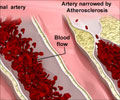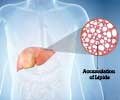A research has found that children with HIV are at heightened risk of developing atherosclerosis.

EUROECHO and other Imaging Modalities 2012 is the annual meeting of the European Association of Cardiovascular Imaging (EACVI)2, a registered branch of the European Society of Cardiology (ESC)3. It takes place 5-8 December in Athens, Greece, at the Megaron Athens International Conference Center.
Antiretroviral treatment is prolonging the lives of HIV patients, who no longer die prematurely from the infection. But the treatment is not a cure, and the virus remains in the body. "The infection makes the body fight for its life, so the immune system is always activated and there is chronic inflammation," said Dr Talia Sainz Costa, principal investigator of the study and a pediatrician from Madrid, Spain.
In addition, many antiretroviral drugs increase bad (LDL) cholesterol and lower good (HDL) cholesterol. Dr Sainz Costa said: "Children with HIV will have high cholesterol for a long period and on top of that the virus causes chronic inflammation - both are bad for the arteries."
Patients with HIV die 10 years prematurely from non-AIDS disease which includes cardiovascular diseases, cancer, liver and renal diseases. "This is especially important for children because they have been living with HIV since birth or even before," said Dr Sainz Costa. "By the time they are 50 years old they will have accumulated more toxicity from the treatment and more secondary effects from the infection and will be at an even greater risk of heart attacks and other complications."
Advertisement
The researchers found that 17% of the HIV group were smokers compared to 11% of the control group. Dr Sainz Costa said: "Smoking levels in adolescents in Spain are known to be high. The even higher levels in the HIV group are probably related to low socioeconomic status and very complex social/family backgrounds."
Advertisement
The researchers also found that frequencies of activated T CD4+ cells were higher among HIV-infected children and young adults (p=0.002). "This shows that the immune system is more active," said Dr Sainz Costa.
They concluded that clinicians need to take cardiovascular prevention more seriously in children and adolescents with HIV, while continuing to treat the HIV infection. Dr Sainz Costa said: "Cardiovascular disease has already put down roots in children and adolescents with HIV and we need to take preventive measures at this early stage. We should be more aggressive in treating their high cholesterol with medication – this practice is common in adults but rare in children."
She added: "We also need to be stricter about healthy lifestyle advice. Many children and adolescents with HIV come from families with low socioeconomic status and are more prone to smoking, poor diet and inactivity. This age group also struggles with adherence to medication which is another worry, but we should not let this decrease our efforts to prevent future complications."
Dr Sainz Costa concluded: "HIV research is investigating ways to control the inflammation and immune activation with agents such as probiotics, aspirin and corticoids. In the meantime clinicians need to focus on ensuring their young patients with HIV take the antiretroviral treatment, take lipid lowering drugs when necessary, and adopt healthier lifestyles."
Source-Eurekalert















